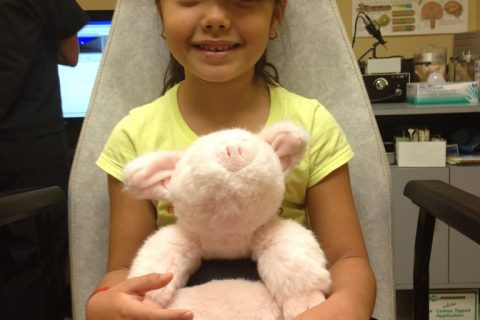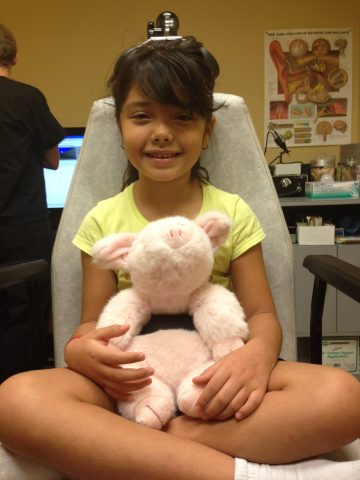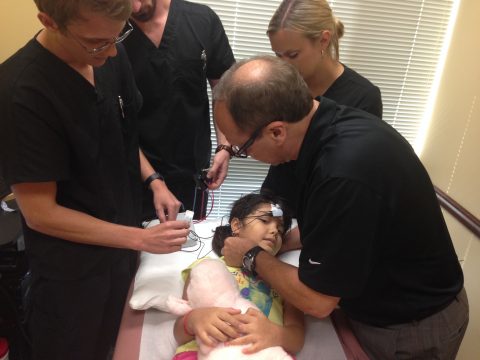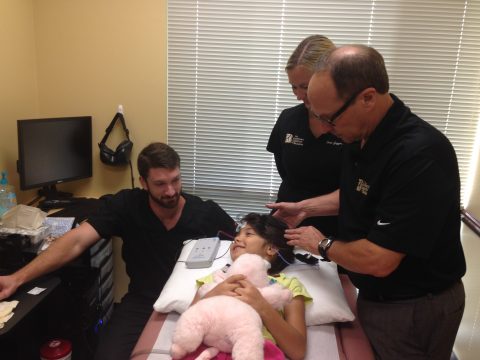
Pediatric Balance Examination
Published on: August 1, 2014
 At AIB, pediatric balance evaluation is a critically important diagnostic service to the medical and rehabilitation community. Evaluation may be conducted with neonates/infants as young as 3 months of age. The evaluation will include both behavioral and electrophysiological evaluation, depending on the age-appropriateness of each component. Even without advanced instrumentation e.g. rotary chair and VEMP, behavioral testing is easily performed and should be of good reliability. All too often the “ear” of a child is only considered as an organ of hearing, when it’s primary function and phylogenic development is that of equilibrium.
At AIB, pediatric balance evaluation is a critically important diagnostic service to the medical and rehabilitation community. Evaluation may be conducted with neonates/infants as young as 3 months of age. The evaluation will include both behavioral and electrophysiological evaluation, depending on the age-appropriateness of each component. Even without advanced instrumentation e.g. rotary chair and VEMP, behavioral testing is easily performed and should be of good reliability. All too often the “ear” of a child is only considered as an organ of hearing, when it’s primary function and phylogenic development is that of equilibrium.
Indicators for evaluation:
- Congenital or acquired sensorineural hearing loss.
- Identified syndromes or mitochondrial conditions (with or without hearing loss).
- Congenital craniofacial anomalies (with or without hearing loss).
- Delayed motor milestones including clumsiness or falls.
- Chronic middle ear effusion accompanied by change in gait.
- BPV Infancy type symptoms (with or without torticollis)
- Adolescence-Puberty onset vestibular migraine
- Head trauma – concussion (mTBI)
Protocols:
We accept neonates and infants for evaluation at age 3 months. Protocols are based on age-appropriate or the level of the child’s functioning.
-
Peabody Developmental Motor Scales (subsets): 3 months
-
Observation and review of motor milestones: 3 months
-
Motor control – righting reflexes/dynamic: 3 months
-
Ocular Motility and Optokinetic Reflexes: 3 months
-
VOR observation (rotation/swing):3 months
-
Provoked Vertigo Test (BPPV- post head trauma): age open
-
Clinical Test of Sensory Integration of Balance (CTSIB): 3 years
-
Dynamic Visual Acuity Test: 4-5 years
Electrophysiological
-
-
Passive Head Rotation (Rotary Chair): 2 years
-
Active Head Rotation (VORTEQ): 3 years
-
VideoNystagmography (VNG) w/calorics: 4 years
Intervention & Management:
- Triage to medical/rehabilitative specialists as indicated
- Vision testing
- Physical and Occupational therapy as indicated based on integrity of all sensory modalities
- Follow-up testing as child ages or is under treatment, for ongoing documentation of status
- Post concussion with serial monitoring of progress: balance-oscillopsia etc.
- Education- child safety information for parents, teachers and caregivers
References:
- Gans, R.E., Evaluation and Management of Vestibular Function in Infants and Children with Hearing Loss, In Madell, J.R. and Flexer, C., (2014) Pediatric Audiology Diagnosis, Technology and Management, Thieme Medical Publishers, Inc. New York.
- O’Reilly, R.C., Morlet, T., Nicholas, B.D., et al. (2010) Prevelance of vestibular and balance disorders in children., Otology & Neurotology, 31 (9), 1441-1444
- Rine, R.M. Evaluation and Treatment of Vestibular and Postural Control Deficits in Children, In Herdman, S.J., (2000) Vestibular Rehabilitation, F.A. Davis, Philadelphia

